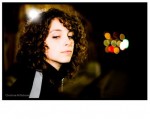 A night-time photo shoot often presents a problem or two, especially when including an element of interest in the background such as architecture. In most cases a tripod or some other method of stabilizing the camera will be necessary due to the slow shutter speeds used with low-light photography. But even with a tripod, our subject needs to remain somewhat statuesque to prevent blurring. If you’ve ever tried portraits at night, you’ll know that getting clean sharp shots is almost impossible when there’s any kind of movement.
A night-time photo shoot often presents a problem or two, especially when including an element of interest in the background such as architecture. In most cases a tripod or some other method of stabilizing the camera will be necessary due to the slow shutter speeds used with low-light photography. But even with a tripod, our subject needs to remain somewhat statuesque to prevent blurring. If you’ve ever tried portraits at night, you’ll know that getting clean sharp shots is almost impossible when there’s any kind of movement.
We often end up turning on our flash to get around this issue. But this leads us into another problem. Using frontal flash at night will certainly capture your subject, but everything that’s outside of your flash range, everything in the background will disappear into blackness. The resulting shot will be simply your bright subject, in a sea of blackness.
So in low light, how do we include the subject AND the background?
The answer is slow-sync flash.
It’s a pretty simple concept that combines long exposure with flash photography. There are two types of slow-sync flash available to us, and they will each produce their own unique results. The two types are “front curtain” or “rear curtain”. Either method can be used in an environment where everything is still with little difference in the outcome, not forgetting that a tripod would still be necessary in most cases. However, if you’re trying to capture any kind of movement within the scene, it’s important to choose the technique that will provide you with the desired result.
Front-curtain: The flash is fired at the start of the shot – right when the shutter opens. The flash will illuminate the subject and foreground, and the shutter will remain open for the remainder of the shot – long enough to capture everything else in the background.
Rear-curtain: Basically the opposite of the above. The shutter is opened for as long as necessary – long enough to capture the background, and then at the very last minute, the flash will fire to illuminate the subject and foreground.
As an example, try to imagine a scene where there is a little bit of frontal lighting. There’s a building or a large sculpture in the background that has been up-lit, and we want to capture both our subject, who is close-by AND the background architecture. We decide to use the rear-curtain technique and an exposure of around 10 seconds. As we press the shutter button our subject begins to walk through the frame from the left-hand side – and we time it so that the flash fires just as they are about to exit to the right. The resulting shot will show our subject about to exit the frame, but with light trails behind them – perhaps giving the feeling of a speedy exit.
What results do you think the front curtain method would produce? If you were to have the flash fire as the subject enters the scene, then leave the shutter open as they walk through the frame. What effect do you think that would have on the resulting photo?